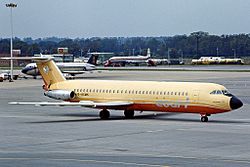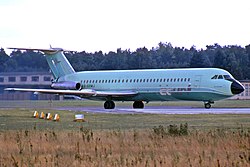Court Line
| Court Line | |
|---|---|

|
|
| IATA code : | (without) |
| ICAO code : | OU |
| Call sign : | COURTLINE |
| Founding: | 1957 (as Argus Air Transport) |
| Operation stopped: | 1974 |
| Seat: | London Luton Airport |
| Home airport : | London Luton Airport |
| Number of employees: | 1150 (1974) |
| Passenger volume: | 2.2 million (1973) |
| Fleet size: | 11 |
| Aims: | Mediterranean, Canary Islands, Caribbean |
| Court Line ceased operations in 1974. The information in italics refer to the last status before the end of operation. | |
Court Line (officially Court Line Aviation Ltd.) was a British charter airline that ceased operations in August 1974. The company was formed at the beginning of 1970 from the renaming of Autair International Airways , which in turn emerged from Argus Air Transport in 1960 .
Autair (Luton)
The company was founded in January 1957 under the name Argus Air Transport . In 1960, Autair Helicopter Service , which had been operating on- demand flights with Sikorsky S-51 helicopters around the world since 1953 , acquired the London-Luton- based company and renamed it Autair (Luton) . Autair began flight operations in early 1961 with three Douglas DC-3s . From the summer of 1962, the company also carried out charter flights and freight transports from Berlin-Tempelhof . Due to the increasing demand for package tours , the fleet was continuously enlarged by purchased aircraft of the types Vickers Viking (from 1962) and Airspeed Ambassador (from 1963). The large number of international charter flights led to the renaming of the company in Autair International Airways on September 27, 1963 .
Autair International Airways
In addition to the charter services, the company began building a scheduled flight network in 1963. First, a daily scheduled flight between London-Luton and Blackpool Airport was set up from October 1, 1963 . Glasgow and Hull airports were integrated into the route network in 1966. The company opened its first international line connection on April 1, 1967 between Hull and Amsterdam .
On April 15, 1965, the airline was taken over by the British shipping company Court Line Group for a purchase price of £ 215,000 . With the bankruptcy of the charter airline Treffield International Airways in June 1967, the company was able to secure additional market shares. For further expansion Autair ordered jet aircraft of the type BAC 111-400 , which were delivered from 1968.
On October 31, 1969, the company stopped all scheduled flight connections for economic reasons and concentrated exclusively on tourist charter flights. The propeller planes that were no longer needed were sold or returned to the lessor.
Court Line Aviation

On 1 January 1970, the renaming of carried Autair International Airways to Court Line Aviation . At the same time, a corporate identity designed by the designer Peter Murdoch was presented, which corresponded to the contemporary appearance of a “vacation airline”. For this purpose, the aircraft were painted in striking, individually different colors. In addition, all machines were given a baptismal name that began with the word "Halcyon" (German: "peaceful").
In early 1970, the company gradually replaced its existing BAC 111-400 with the extended version BAC 111-500 . In order to further increase the number of passengers in the new aircraft, a galley was not installed. Instead, the passengers received their on-board catering from bags that were placed in compartments that were let into the backrests of the seats before departure.
Due to the continued high growth rates in the tourism business, the company ordered two Lockheed L-1011 TriStar in October 1971 . The widebody wrong from 1 April 1973 mainly to Spain and made Courtline Aviation European first operator of this aircraft type. From November 1973 the company also used the aircraft on long-haul flights from London-Luton to St. Lucia . After arriving in the Caribbean , the tourists were transported on by aircraft operated by the regional airline LIAT , which the Court Line Group had already taken over for this purpose in November 1971 .
The ruinous price war between British tour operators led to the bankruptcy of the Clarksons tourist company in April 1973 , which contributed 40 percent to the Court Line's passenger volume. In order to ensure the utilization of the aircraft, the company took over the travel provider and its liabilities. This investment initially paid off: with over 2.2 million passengers carried, Court Line became the market leader among British charter airlines in 1973. As a result of the first oil crisis , the company's operating costs increased significantly from autumn 1973. At the same time, the number of bookings on the British tourism market collapsed by 30 percent. The effects of the oil crisis also had an impact on the maritime business fields of the Court Line Group in 1974 , so that the liquidity of the entire group deteriorated. On August 15, 1974, the company became insolvent. The flight operations ceased on the same day, which left around 49,000 tourists in their holiday destinations.
fleet

Fleet at the end of operations
At the time of the cessation of operations, Court Line Aviation's fleet consisted of two Lockheed L-1011 TriStar and nine BAC 111-500s (one each was leased to Cyprus Airways and Germanair ).
Previously deployed aircraft
Autair International Airways:
- Airspeed Ambassador
- BAC 111-400
- Douglas DC-3
- Douglas DC-4
- Handley Page Herald
- Hawker-Siddeley HS 748
- Vickers Viking
for internal company purposes and training flights:
Court Line Aviation:
for internal company purposes and training flights:
- Bell 206
- Blackburn Beverley (bought for the transport of engines, but the machine did not receive a civil license and could therefore not be used)
- Hawker Siddeley HS.125
- Piper PA-31
Incidents

- On September 14, 1967, an Airspeed Ambassador ( registration : G-ALZS) from Autair rolled over the end of the runway after landing in London-Luton. The aircraft was written off as a total loss. All 69 occupants of the machine were uninjured.
- On December 23, 1967, a Hawker Siddeley HS.125 (G-AVGW) of Autair crashed on a training flight in Luton. The crew simulated an engine failure and lost control of the aircraft during a go-around maneuver. Both pilots were killed in the crash.
- On April 18, 1974, a BAC 111-500 (G-AXMJ) of the Court Line collided while taking off at London-Luton Airport with a Piper Aztec that had rolled onto the runway without permission. The pilot of the small aircraft was killed in the accident and the second person on board was injured. The 91 occupants of the airliner were not injured.
See also
Web links
Individual evidence
- ^ Flight International, March 26, 1970
- ↑ a b c d e Leisure Airlines of Europe, K. Vomhof, Newcastle-upon-Tyne 2001
- ↑ Flight International, June 2, 1966, p. 916 [1]
- ↑ Autair flight plans, various years [2]
- ↑ Flight International, April 22, 1965, p. 629 [3]
- ↑ Flight International, August 7, 1969, p. 192 [4]
- ↑ Flight International, March 19, 1970, p. 439 [5]
- ↑ Black Enterprise, April 1977, p. 65 [6]
- ↑ Flight International, May 3, 1973, p. 663 [7]
- ↑ a b Flight International, August 22, 1974, p. 198 [8]
- ↑ jp aircraft-markings, various years
- ↑ Aviation Safety Network, September 14, 1967 [9]
- ↑ Aviation Safety Network, September 23, 1967 [10]
- ^ Aviation Safety Network, April 18, 1974 [11]
